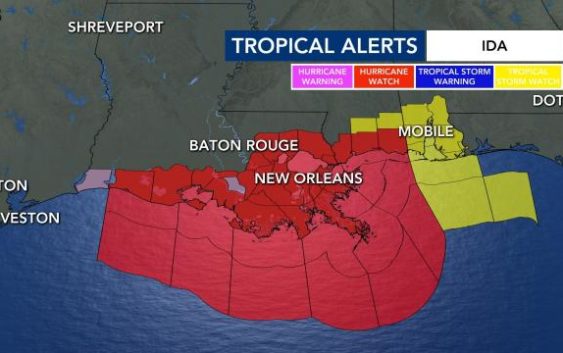- Austin leaders consider expanding wildfire protection plan
- Large hail, strong winds and tornado threat possible into Thursday evening
- Large hail, tornado threat possible Thursday evening
- Jaccob Slavin scores in OT as the Hurricanes beat the Capitals in Game 1 of their 2nd-round series
- 5 On Your Side: What happened to cars flooded during Hurricane Helene?
Parts of Louisiana ordered to evacuate as Ida gains hurricane status

Ida was upgraded to a hurricane on Friday afternoon as it moved over warm waters near the Gulf States.
Winds are expected to be 120 mph when Ida arrives on Louisiana’s coast. Forecasters say the storm is expected to bring significant damage to the region.
The storm is expected to be at or near major hurricane strength when it makes landfall near Louisiana late Sunday.
The mayor of New Orleans called for everyone outside the levee system to evacuate before Ida hits Louisiana.
The National Weather Service warned residents that local levees could be overtopped during the storm.
“Unfortunately, all of Louisiana’s coastline is currently in the forecast cone for Tropical Storm Ida, which is strengthening and could come ashore in Louisiana as a major hurricane as Gulf conditions are conducive for rapid intensification,” Gov. John Bel Edwards said.
“By Saturday evening, everyone should be in the location where they intend to ride out the storm.,” the governor added.
A hurricane watch was in effect for Cameron, Louisiana, to the Mississippi-Alabama border — including Lake Pontchartrain, Lake Maurepas and metropolitan New Orleans
Hurricane and storm surge watches have been issued along the Gulf coast for portions of Louisiana, Mississippi and Alabama.
Messages from the National Hurricane Center show an increasing risk of life-threatening storm surge and hurricane-force winds.
Model plots show the storm could take a right turn and head toward North Carolina. Our state could get rain from Ida early next week, but impacts are not expected to be severe.
Tropical moisture could interact with a boundary that’s up in Virginia, WRAL meteorologist Elizabeth Gardner said. Ida could affect communities in the mountains near Asheville and the north part of the WRAL viewing area.
Two other systems are unlikely to affect the U.S. as they curve around an large area of high pressure centered in the far eastern Atlantic.
The peak of the Atlantic hurricane season is Sept. 10. Historically, mid-August through October is the most active period of the Atlantic season.


